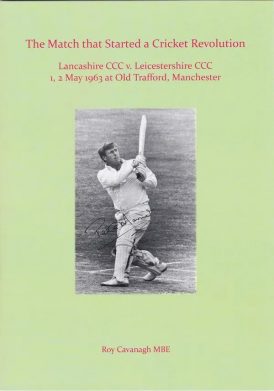The Match That Started A Cricket Revolution
Martin Chandler |Published: 2023
Pages: 16
Author: Cavanagh, Roy
Publisher: Red Rose Books
Rating: 3.5 stars

Cricket has been played in England for well over 400 years, and the first match now generally reckoned as being ‘First Class’ took place as long ago as 1772. The game has of course changed as time has passed, but the pace of change has increased rapidly in recent years, and it is a sobering thought that the very first top level limited overs match took place as recently as 1963.
Did anyone at Old Trafford on 1 and 2 May 1963 foresee the advent of T20, T10, the IPL or The Hundred? That they didn’t is something of which I have no doubt. It was quite revolutionary enough for English cricket to introduce a knock out trophy of any sort. There was a slight issue however, as with seventeen First Class counties there was one too many for a first round followed by quarter-finals, semi-finals and a prestigious final at Lord’s.
So one county had to go out early, and Lancashire and Leicestershire, having filled the last two places in the County Championship at the end of the previous summer, were required to play a preliminary fixture to decide which of them would join the other fifteen counties in the quest for the first ever Gillette Cup.
It was perhaps inevitable that the Manchester weather would have a say, and ironically enough what should have been the first one day match between two English First Class counties had to go into a second, reserve, day in order to see a conclusion. The match itself was 65 six ball overs per side with, other than a limit of 15 overs per bowler, essentially the same rules applying as would have applied to a County Championship fixture.
What happened? You will, naturally, have to buy the monograph to get the full account, but it is in the record books for all to see that Lancashire, building on a century by Peter Marner*, made enough runs to see off their opponents from the East Midlands by 101 runs despite the visitors’ skipper, Maurice Hallam, also making three figures. Marner’s medium pace brought him three wickets to go with his 121 and the man of the match adjudicator, the legendary Frank Woolley, did not have an onerous task.
I had hoped that author Roy Cavanagh might have been at the game, but in the event he was not one of the 500 hardy souls who turned up on the first day. That said he has clearly read every word written by those who were there, and he provides an excellent account of a fine performance by the Red Rose.
From the events of May 1 and 2 Lancashire went on to beat Essex and Derbyshire before losing in the semi-final to Worcestershire. The reason isn’t difficult to see, a telling comment from Marner being quoted by Cavanagh, we never really discussed tactics, just treated it as a normal game – the sport has changed just a tad since then!
The Match That Started A Cricket Revolution is an excellent idea, and should be of interest both to those of us who can remember the days before T20 was even thought of, as well as younger folk who have no idea what life was like when nearly all top level cricket in England was played over three or five days. Personally I suspect that the 60 copies that Red Rose Books have printed won’t be enough to go round, so order early is my advice.
*At the end of the following season, following what could fairly be described as a clash with the powers that be at Old Trafford, Marner left Lancashire for Leicestershire. An interesting cricketer, I take this opportunity of expressing the hope that someone connected with Red Rose Books is planning to write, if not a biography, then certainly an extended monograph looking at the life and times of a man whose record for his second county is considerably better than that for his first.






Leave a comment